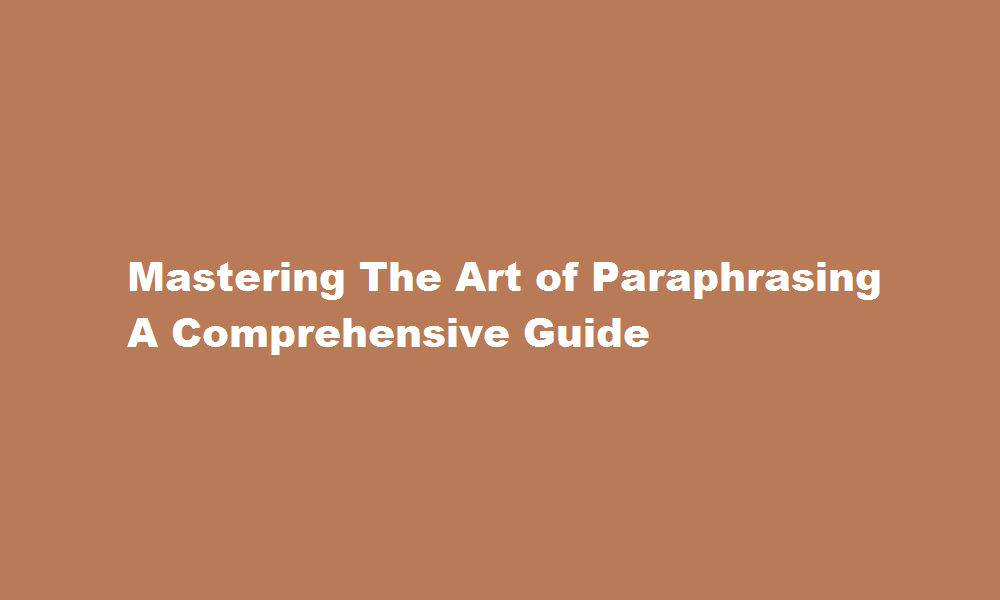Mastering The Art of Paraphrasing A Comprehensive Guide
3 min read
Introduction
Paraphrasing is an essential skill in effective communication and academic writing. It involves restating someone else’s ideas or information in your own words, while maintaining the original meaning. In this article, we will explore the importance of paraphrasing and provide a step-by-step guide to help you master this skill. Whether you are a student, professional, or simply looking to enhance your writing abilities, understanding how to paraphrase effectively will greatly improve your communication and avoid plagiarism concerns.
Why Paraphrasing Matters
Paraphrasing serves several crucial purposes. First and foremost, it helps you avoid plagiarism by providing an ethical approach to incorporating external sources into your work. By paraphrasing, you demonstrate your understanding of the source material and contribute your unique perspective. Moreover, paraphrasing allows you to simplify complex information, making it more accessible to your target audience. It also enables you to maintain consistency in writing style and tone throughout your work, promoting coherence.
Step-by-Step Guide to Paraphrasing
- Understand the Source Material Read the original text carefully to grasp the main idea and supporting details. Take note of any technical terms or specific phrases that you may need to retain.
- Use Different Sentence Structures Avoid replicating the sentence structure of the source. Instead, restructure sentences using synonyms, alternative phrasing, and different grammatical constructions. This approach will help you convey the information in a fresh and original manner.
- Replace Key Terms Identify the significant terms or keywords in the original text and replace them with suitable synonyms. Thesauruses and online dictionaries can be valuable resources for finding alternative words.
- Rearrange Sentence Order Rearranging the order of sentences or paragraphs can contribute to a more coherent and well-organized paraphrase. Ensure that the logical flow of ideas is maintained.
- Focus on the Main Ideas Emphasize the main concepts and ideas from the original text while omitting minor details or examples that are not essential. This helps you condense the information and make it more concise.
- Use Quotation Marks for Direct Quotes If you come across a specific phrase or expression that cannot be effectively paraphrased, enclose it in quotation marks to indicate that it is a direct quote. Remember to include proper citations.
- Compare Your Paraphrase with the Original After paraphrasing, compare your version with the original text to ensure that the meaning has been accurately conveyed. Check for any unintentional similarities and make necessary revisions.
- Cite Your Sources Always provide proper citations for the original sources you have paraphrased. This helps acknowledge the original authors and allows readers to locate the original material.
Practical Tips for Effective Paraphrasing
- Practice regularly to improve your paraphrasing skills. The more you practice, the more natural and fluent your paraphrasing will become.
- Take breaks during the paraphrasing process to avoid unintentional plagiarism. Clear your mind and focus on expressing the information in your own words.
- Consult style guides or writing handbooks for specific guidelines on paraphrasing and citation styles. Different fields may have different requirements.
- Seek feedback from peers, professors, or writing tutors to refine your paraphrasing abilities. Constructive criticism will help you identify areas for improvement.
FREQUENTLY ASKED QUESTIONS
What is the main rule of paraphrasing?
The general rule for paraphrasing and summarizing is that you should not repeat more than four sequential words from the original text, although some authorities have limited the number to three sequential words.
What is not allowed in paraphrasing?
Changing a few words and omitting others is not enough for proper paraphrasing. You must really understand what the phrase means and then put it in your own words.
Conclusion
Paraphrasing is a valuable skill that allows you to incorporate external sources while maintaining your own voice in writing. By following the step-by-step guide and implementing the practical tips provided in this article, you can become a proficient paraphraser. Remember, paraphrasing not only helps you avoid plagiarism but also enhances the clarity and effectiveness of your writing. Practice regularly and seek feedback to continually refine your skills. With dedication and practice, you will master the art of paraphrasing and become a more confident and proficient communicator.
Read Also : Demystifying Date Parsing in Java A Comprehensive Guide






